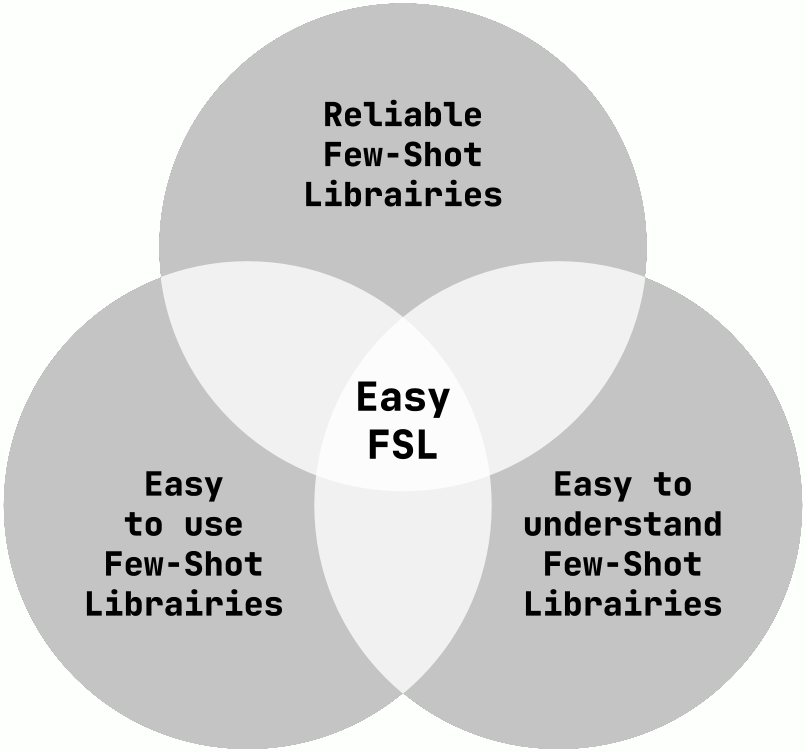Ready-to-use code and tutorial notebooks to boost your way into few-shot image classification. This repository is made for you if:
- you're new to few-shot learning and want to learn;
- or you're looking for reliable, clear and easily usable code that you can use for your projects.
Don't get lost in large repositories with hundreds of methods and no explanation on how to use them. Here, we want each line of code to be covered by a tutorial.
You want to learn few-shot learning and don't know where to start? Start with our tutorial.
-
First steps into few-shot image classification: basically Few-Shot Learning 101, in less than 15min.
-
Example of episodic training: use it as a starting point if you want to design a script for episodic training using EasyFSL.
-
Example of classical training: use it as a starting point if you want to design a script for classical training using EasyFSL.
State-Of-The-Art Few-Shot Learning methods:
- FewShotClassifier: an abstract class with methods that can be used for any few-shot classification algorithm
- Prototypical Networks
- Matching Networks
- Relation Networks
- Fine-Tune
- BD-CSPN
- Transductive Fine-Tuning
- Transductive Information Maximization
To reproduce their results, you can use the standard network architectures used in Few-Shot Learning research. They're also a feature of EasyFSL!
Tools for data loading:
Data loading in FSL is a bit different from standard classification because we sample batches of instances in the shape of few-shot classification tasks. No sweat! In EasyFSL you have:
- TaskSampler: an extension of the standard PyTorch Sampler object, to sample batches in the shape of few-shot classification tasks
- FewShotDataset: an abstract class to standardize the interface of any dataset you'd like to use
- EasySet: a ready-to-use FewShotDataset object to handle datasets of images with a class-wise directory split
And also: some utilities that I felt I often used in my research, so I'm sharing with you.
There are enough datasets used in Few-Shot Learning for anyone to get lost in them. They're all here, explicited, downloadable and easy-to-use, in EasyFSL.
We provide a script to download and extract the dataset, along with the standard (train / val / test) split along classes. Once you've downloaded the dataset, you can instantiate the Dataset objects in your code with this super complicated process:
from easyfsl.datasets import CUB
train_set = CUB(split="train", training=True)
test_set = CUB(split="test", training=False)To use it, you need the ILSVRC2015 dataset. Once you have downloaded and extracted the dataset, ensure that its localisation on disk is consistent with the class paths specified in the specification files. Then:
from easyfsl.datasets import TieredImageNet
train_set = TieredImageNet(split="train", training=True)
test_set = TieredImageNet(split="test", training=False)Same as tieredImageNet, we provide the specification files, but you need the ILSVRC2015 dataset. Once you have it:
from easyfsl.datasets import MiniImageNet
train_set = MiniImageNet(root="where/imagenet/is", split="train", training=True)
test_set = MiniImageNet(root="where/imagenet/is", split="test", training=False)Since miniImageNet is relatively small, you can also load it on RAM directly at instantiation simply by
adding load_on_ram=True to the constructor.
It takes a few minutes but it can make your training significantly faster!
I've recently started using it as a Few-Shot Learning benchmarks, and I can tell you it's a great playing field. To use it, first download the data:
# Download the original dataset (/!\ 110GB)
wget http://ptak.felk.cvut.cz/plants/DanishFungiDataset/DF20-train_val.tar.gz
# Or alternatively the images reduced to 300px (6.5Gb)
wget http://ptak.felk.cvut.cz/plants/DanishFungiDataset/DF20-300px.tar.gz
# And finally download the metadata (83Mb) to data/fungi/
wget https://public-sicara.s3.eu-central-1.amazonaws.com/easy-fsl/DF20_metadata.csv -O data/fungi/DF20_metadata.csvAnd then instantiate the dataset with the same process as always:
from easyfsl.datasets import DanishFungi
dataset = DanishFungi(root="where/fungi/is")Note that I didn't specify a train and test set because the CSV I gave you describes the whole dataset. I recommend to use it to test models with weights trained on an other dataset (like ImageNet). But if you want to propose a train/val/test split along classes, you're welcome to contribute!
-
Install the package:
pip install easyfslor simply fork the repository. -
Design your training and evaluation scripts. You can use our example notebooks for episodic training or classical training
This project is very open to contributions! You can help in various ways:
- raise issues
- resolve issues already opened
- tackle new features from the roadmap
- fix typos, improve code quality




